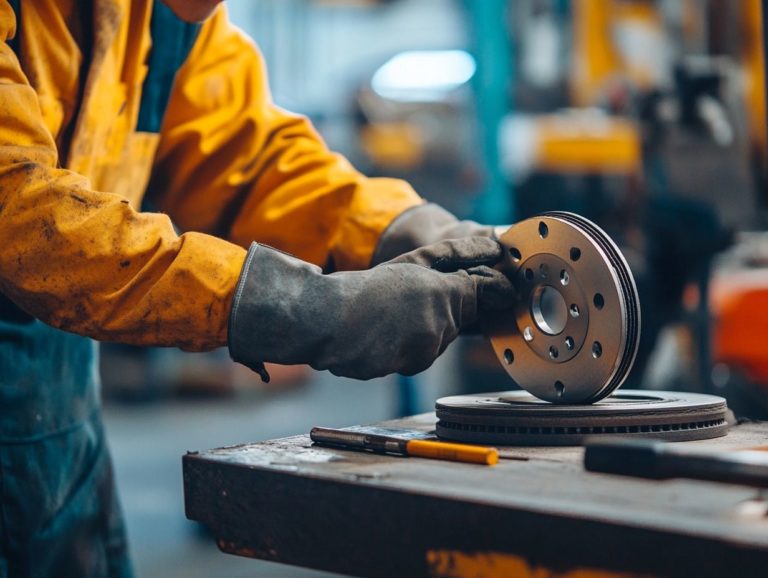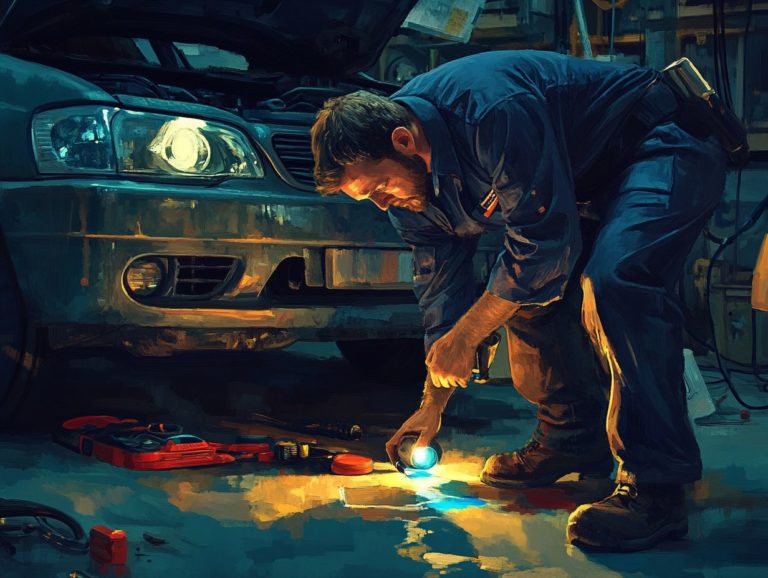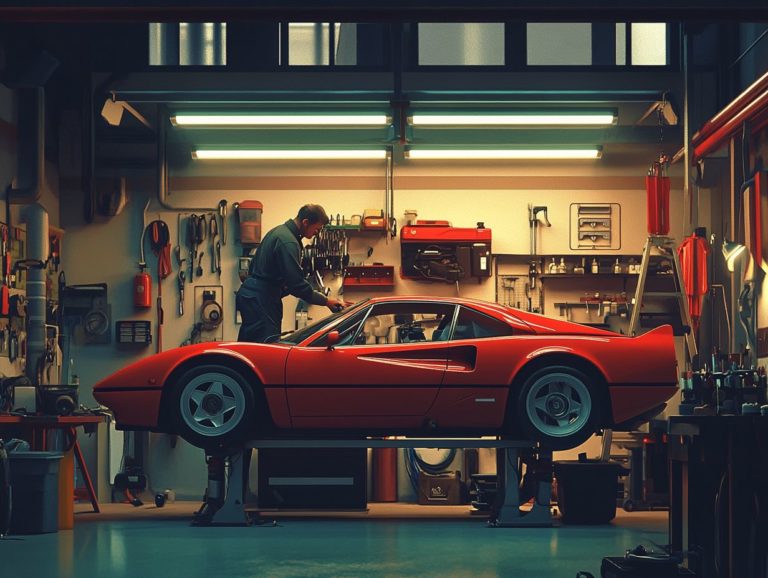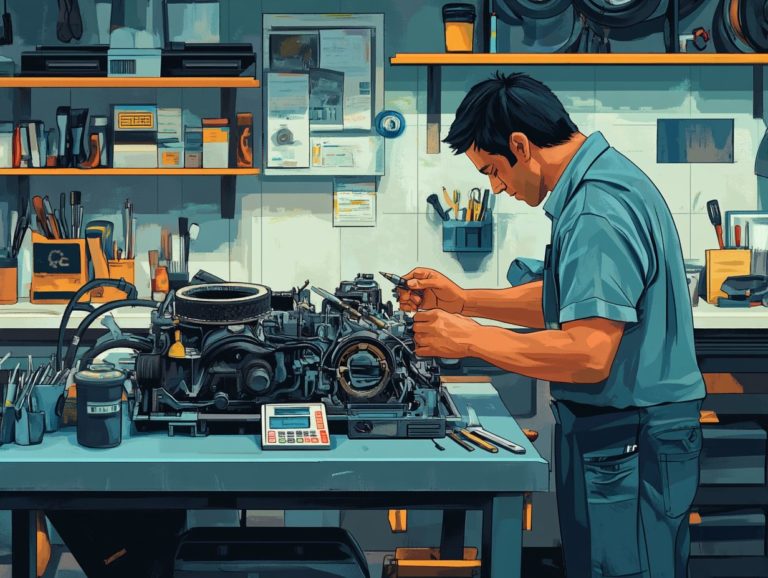5 Essential Tips for Common Car Maintenance
Keeping your car in great shape is essential for a smooth and safe ride! Yet many drivers often overlook fundamental upkeep.
Here are five essential tips to keep your vehicle running seamlessly. From checking oil and fluid levels to ensuring your tires are inflated to the proper pressure, these steps are vital.
We ll cover common maintenance tasks, the signs to watch for, and how following a maintenance schedule can save you money.
Elevate your driving experience and extend the lifespan of your vehicle!
Contents
- Key Takeaways:
- 1. Regularly Check Your Oil and Fluid Levels
- 2. Keep Your Tires Inflated Properly
- 3. Change Your Air Filter Regularly
- 4. Inspect and Replace Worn Out Belts and Hoses
- 5. Follow the Recommended Maintenance Schedule
- What Are the Benefits of Regular Car Maintenance?
- How Often Should You Check Your Oil and Fluid Levels?
- What Are the Dangers of Underinflated Tires?
- How Often Should You Change Your Air Filter?
- What Are the Signs of Worn-Out Belts and Hoses?
- What Are the Consequences of Not Following the Recommended Maintenance Schedule?
- What Are Some Do-It-Yourself Car Maintenance Tasks You Can Do?
- When Should You Take Your Car to a Professional Mechanic?
- How Can Regular Car Maintenance Save You Money?
- What Are the Most Important Components to Check in a Car?
- How Can You Extend the Life of Your Car?
- What Are the Most Common Car Maintenance Mistakes?
- How Can You Keep Track of Your Car’s Maintenance Needs?
- What Are Some Tips for Maintaining Your Car During Different Seasons?
- Why High-Quality Car Parts Are Essential for Your Vehicle!
- Frequently Asked Questions
Key Takeaways:
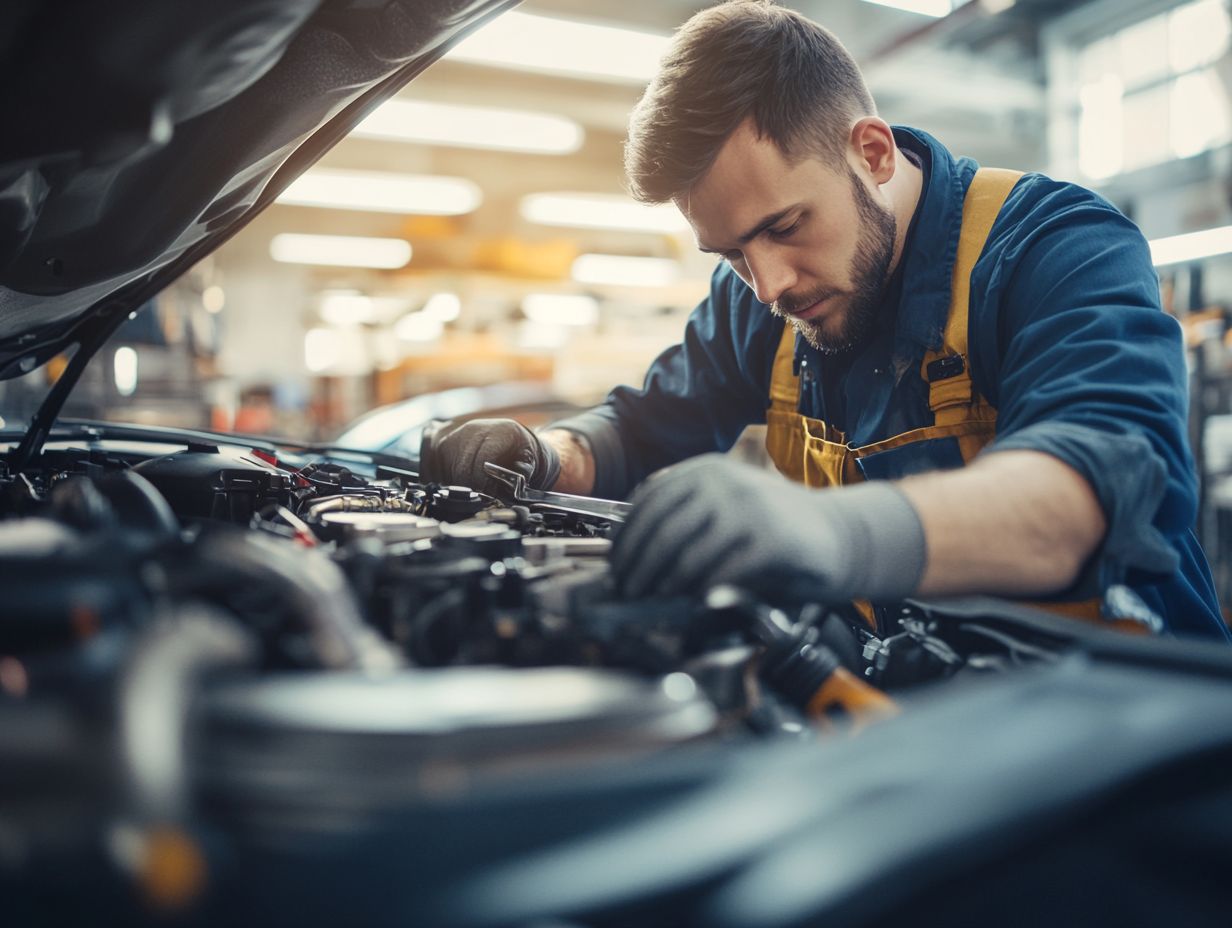
1. Regularly Check Your Oil and Fluid Levels
Regularly checking your oil and fluid levels is crucial for your car’s performance and longevity. By ensuring all components function smoothly, you can prevent costly repairs down the line.
Keeping an eye on your oil, coolant, and other fluids impacts your vehicle’s overall health and fuel economy, making it a vital part of car maintenance.
Don’t forget to routinely inspect your coolant and brake fluid. Checking your coolant levels is especially important in extreme temperatures, as low coolant can lead to overheating.
Also, monitor your brake fluid; degraded fluid can compromise braking efficiency and pose serious safety risks. Ideally, assess these fluids at least once a month or before long trips.
Watch for signs of low fluid levels, like warning lights on your dashboard, unusual engine temperatures, or strange noises. Regular oil changes maintain engine efficiency and promote cleaner operation, extending your vehicle’s lifespan.
2. Keep Your Tires Inflated Properly
Maintaining the correct tire pressure is essential for safety. It ensures optimal driving performance, fuel efficiency, and tire longevity. Surprisingly, this critical aspect of car maintenance often gets overlooked.
By checking your tire pressure regularly, you can avoid issues stemming from underinflated tires, such as poor handling and increased fuel consumption.
To check the pressure, use a reliable tire gauge and measure when the tires are cold for the most accurate reading. Consult your vehicle’s owner manual or the placard on the driver s side door for recommended tire pressure levels, typically ranging from 30 to 35 PSI (pounds per square inch).
Not inflating your tires properly can reduce traction and increase the risk of blowouts, ultimately compromising your safety on the road.
3. Change Your Air Filter Regularly
Regularly changing your cabin air filter and engine air filter is key to ensuring safety, enhancing fuel economy, and creating a comfortable driving experience.
These filters allow for optimal airflow to the engine and maintain clean air within the cabin. Replace these filters every 12,000 to 15,000 miles, but your driving conditions may require more frequent changes.
If you navigate dusty environments or heavy traffic, check those filters regularly. Look for signs of a clogged filter, such as reduced airflow from the vents or an unusual musty odor inside the cabin.
Noticeable dips in engine performance, like sluggish acceleration, may also indicate a clogged filter. Using high-quality filters can significantly boost your engine s performance and improve air quality inside your vehicle, leading to a healthier and more enjoyable driving experience.
Start implementing these tips today and enjoy a smoother, safer drive!
4. Inspect and Replace Worn Out Belts and Hoses
Inspecting and replacing worn belts and hoses is crucial for your vehicle’s safety and preventive maintenance. These components are essential for the operation of your car’s engine and various systems. This helps you steer clear of costly repairs while ensuring your vehicle runs smoothly.
When you perform frequent checks, focus on spotting cracks and frays, or any signs of wear. Pay particular attention to areas where parts rub together frequently. Hoses require your attention as well; look for swelling, leaking, or soft areas that could signal degradation.
It’s generally advisable to inspect these parts every six months and replace them every 30,000 to 50,000 miles. Always refer to your vehicle manufacturer s guidelines for precise recommendations.
Maintaining belts and hoses in top condition not only boosts engine efficiency but also plays a vital role in ensuring overall safety. This prevents unexpected breakdowns during critical moments when you need your vehicle the most.
5. Follow the Recommended Maintenance Schedule
Following the recommended maintenance schedule from your vehicle s manufacturer is crucial for ensuring long-term safety and reliability. This schedule lays out essential tasks like oil changes, coolant checks, and emissions inspections. These keep your car running at its best and help you avoid unexpected repair costs.
By sticking to this schedule, you can guarantee that critical systems such as brakes and tires receive regular inspection and maintenance. For example, a brake fluid check should be on your annual to-do list to prevent deterioration. Tire rotations are typically advised every 5,000 to 7,000 miles to promote even wear.
Engaging in these practices boosts your vehicle’s performance and creates a safer driving environment. Regular maintenance helps you spot small issues before they escalate into significant, costly repairs. This prolongs your vehicle s lifespan and offers you peace of mind on the road.
What Are the Benefits of Regular Car Maintenance?
Regular car maintenance offers a host of benefits that you simply can’t overlook. We’re talking about enhanced vehicle safety, improved fuel economy, and reduced repair costs—all essential for anyone who values the longevity and reliability of their car. For beginners, following the top 10 car maintenance tips can be particularly helpful.
By scheduling routine inspections and timely oil changes, you might spot issues like worn brake pads before they escalate into costly repairs. For instance, a simple tire rotation can extend the life of your tires. This ultimately saves you money while enhancing traction an absolute must for safe driving conditions.
A well-maintained vehicle often translates to better fuel efficiency. This allows you to make fewer trips to the gas station. When you give meticulous attention to maintenance, you significantly reduce the likelihood of automotive issues leading to dangerous situations on the road. This fosters a sense of security for both you and your passengers.
How Often Should You Check Your Oil and Fluid Levels?
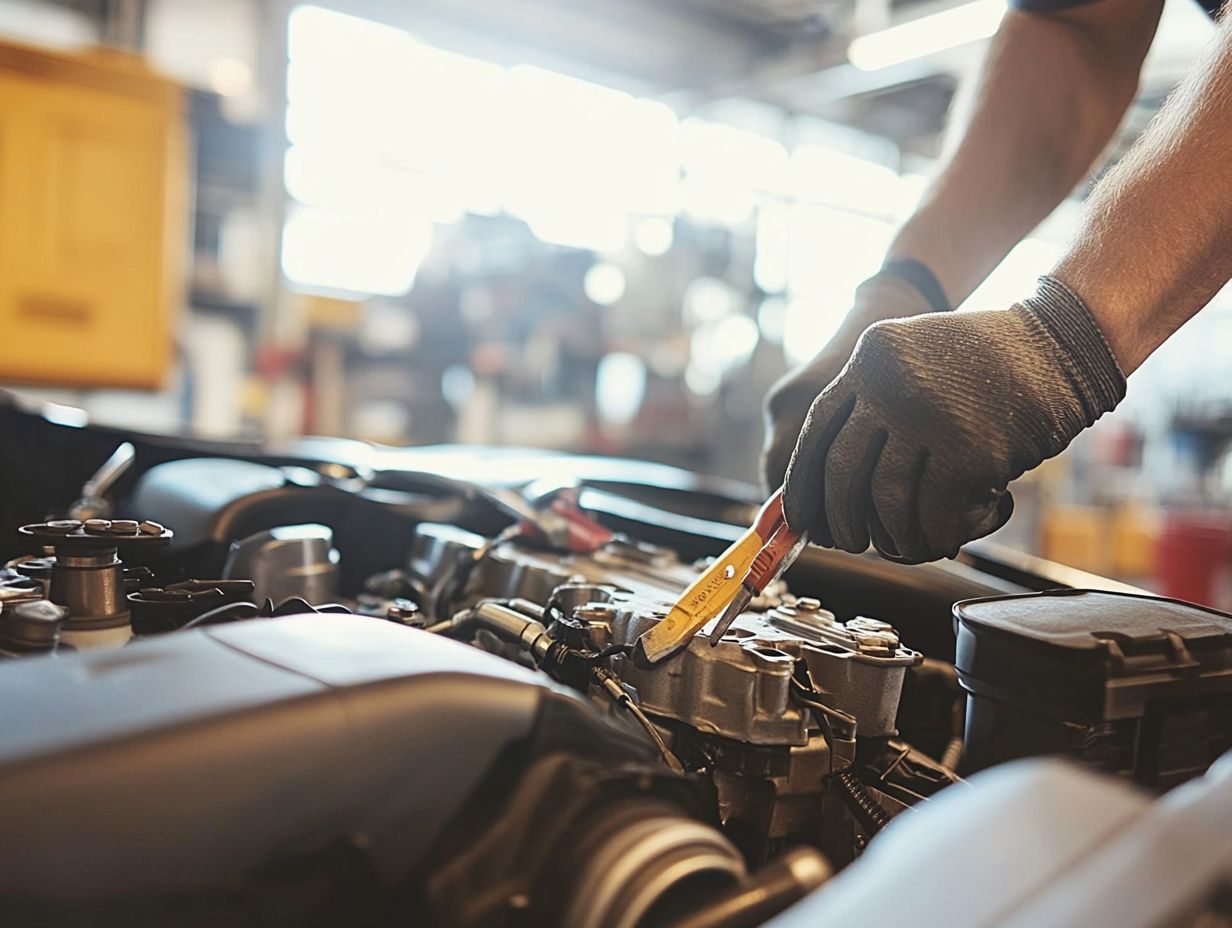
Incorporating routine checks of your oil and fluid levels into your preventive maintenance routine is essential. Experts recommend conducting these checks at least once a month, as well as before embarking on long road trips. This ensures your vehicle remains safe and performs at its best.
Several factors determine how often this crucial task should be carried out. For example, driving conditions such as frequent short trips in stop-and-go traffic or extended highway driving can influence the frequency of your oil and fluid checks. The age of your vehicle matters too; older models may require more regular inspections due to wear and tear.
When you check these levels, ensure that the engine is cool. Use a clean dipstick for the oil, and examine the colors of the fluids for any signs of contamination. Adopting this proactive approach helps maintain your vehicle’s health and can significantly extend its lifespan.
Ready to keep your vehicle in top shape? Create your personalized maintenance checklist now!
What Are the Dangers of Underinflated Tires?
Underinflated tires present serious risks, impacting your vehicle’s safety, fuel economy, and overall tire wear. It’s essential to check and maintain your tire pressure regularly.
When your tires aren’t properly inflated, you may notice a significant dip in traction. This leads to longer stopping distances and less control on wet or slippery roads. It becomes tougher to navigate curves or respond quickly during sudden stops.
The risk of blowouts escalates as the tire’s structural integrity weakens. Consistently driving on underinflated tires can also cause uneven tread wear, which adds to performance issues and might require you to replace the tires sooner than expected.
By keeping an eye on your tire pressure, you enhance safety, optimize your vehicle’s efficiency, and improve its longevity.
How Often Should You Change Your Air Filter?
Changing your air filter regularly is crucial for regular maintenance. Most manufacturers recommend swapping it out every 15,000 to 30,000 miles to ensure your vehicle operates safely and performs optimally.
This guideline can vary based on your driving conditions. If you often navigate dusty environments, like construction sites or rural roads, your filters may clog quicker. If you frequently engage in stop-and-go traffic in urban areas, you may notice a decline in filter condition sooner.
To check your air filter’s status, give it a visual inspection for any dirt or debris. If barely any light shines through when held up to a light source, it’s a clear sign that a replacement is due.
What Are the Signs of Worn-Out Belts and Hoses?
Recognizing the signs of worn-out belts and hoses is essential for vehicle safety. Look for key indicators such as cracking, fraying, or visible wear.
- Unusual noises like squeaking or grinding could signal a slipping belt.
- Noticeable leakage around hoses suggests potential coolant or fluid issues.
Ignoring these signs can significantly impact your vehicle’s performance. A failing serpentine belt can disrupt vital systems like the alternator or power steering.
If you spot any warning signs, act fast and consult a qualified mechanic to avoid serious issues!
What Are the Consequences of Not Following the Recommended Maintenance Schedule?
Neglecting the recommended maintenance schedule can jeopardize your safety and that of your passengers. Reduced vehicle safety, increased repair costs, and diminished reliability are just the beginning.
When essential services like oil changes, brake checks, and tire rotations are overlooked, your vehicle is more likely to experience mechanical failures. Skipping oil changes can lead to engine sludge buildup, which may result in catastrophic engine failure and costly repairs. Worn brake pads can damage the rotors, further escalating replacement costs.
What begins as a minor oversight can snowball into significant financial burdens. Regular maintenance is not merely a recommendation; it s an essential practice for your vehicle’s sustainable operation.
Check your vehicle’s maintenance schedule today for safer driving!
What Are Some Do-It-Yourself Car Maintenance Tasks You Can Do?
You can easily tackle several do-it-yourself car maintenance tasks to keep your vehicle running smoothly, such as checking tire pressure, changing your oil, and replacing the air filter. For more comprehensive guidance, consider these 5 tips for DIY common car repairs, as each of these contributes significantly to your car’s overall health.
Taking on these projects can save you a substantial amount on repairs while ensuring your vehicle operates safely on the road. For example, checking tire pressure is as straightforward as acquiring a reliable tire gauge, which is readily available to most drivers. Once you have the gauge, remove the valve cap, press it onto the valve stem, and note the reading. If your tires are under-inflated, simply refill them to the recommended pressure found in your owner’s manual.
Changing the oil is also easy. It involves draining the old oil, replacing the oil filter, and adding new oil. For this, you ll need an oil filter wrench (which helps remove the oil filter) and a socket set (used for unscrewing bolts). By mastering these tasks, you not only enhance your car’s efficiency but also elevate your confidence as a vehicle owner.
When Should You Take Your Car to a Professional Mechanic?
Don t wait! If you notice any unusual noises, warning lights, or performance hiccups, see a professional mechanic right away. These can signal serious mechanical issues that compromise your safety and can also lead to unexpected repair bills.
Don’t ignore signs like a grinding noise when you brake or that pesky check engine light illuminating on your dashboard. These minor annoyances can turn into major headaches. If you see any fluid leaks beneath your vehicle, addressing them promptly is absolutely essential.
If you’re uncertain about how to find a trustworthy mechanic, asking friends for recommendations or checking out online reviews can be quite helpful. Ensure that the mechanic you choose is certified and has a solid track record with your specific vehicle type. This way, you can drive with confidence, knowing that your automotive care is in capable hands.
How Can Regular Car Maintenance Save You Money?
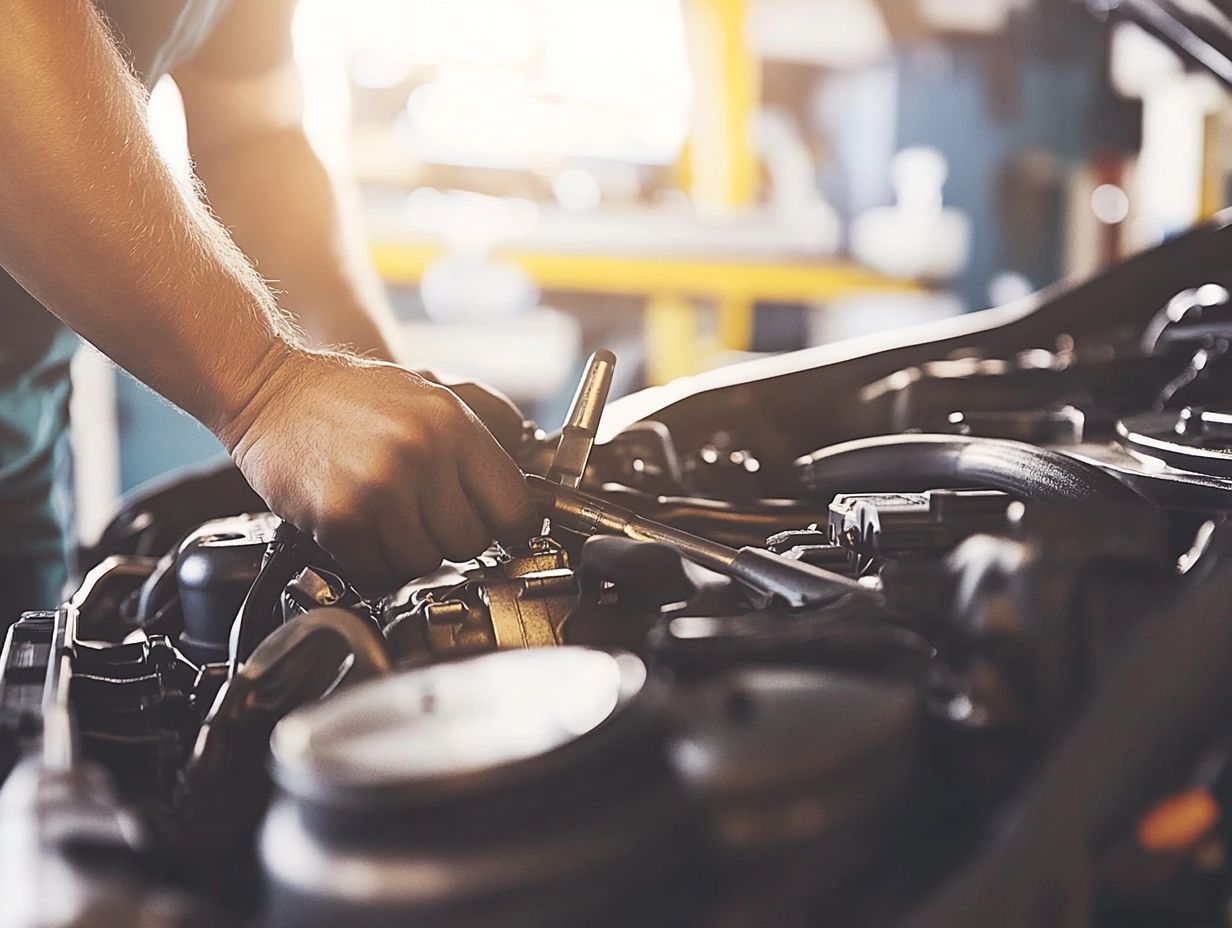
Regular car maintenance is a savvy way to save yourself a significant amount of money in the long run. By preventing costly repairs, enhancing fuel economy, and following the top 10 car maintenance tips for longevity, you’re making a wise investment as a car owner.
By keeping up with essential tasks like oil changes and tire rotations, you can dramatically lower the risk of major breakdowns. For example, if you neglect that oil change, you could end up with thick oil buildup that can damage your engine, which might set you back anywhere from $1,500 to $3,000 in repairs. Likewise, skipping routine tire rotations can lead to wear that isn t balanced, leaving you facing an expensive new set of tires that could cost between $400 and $1,200.
Investing your time and money into these regular maintenance tasks not only protects you from unexpected expenses but also ensures a smoother, more efficient driving experience.
What Are the Most Important Components to Check in a Car?
The most important components you should regularly check in your car include:
- Oil
- Tires
- Brake pads
- Battery
These elements are crucial for ensuring your vehicle s safety and performance, and consistent inspections are essential to prevent unexpected breakdowns.
Monitoring your oil levels and quality is key; it keeps the engine running smoothly and minimizes the risk of severe damage from inadequate lubrication. Tires, too, require your attention inspect them for tread wear and proper inflation to guarantee optimal traction and fuel efficiency, ideally doing this at least once a month.
In terms of brake pads, their thickness is vital for stopping power. Checking them every few thousand miles can help you avoid dangerous braking failures. Don t forget the battery; testing it for charge and corrosion every six months will help you sidestep starting issues and maintain your electrical systems.
By incorporating these checks into your maintenance schedule, you re not just enhancing safety; you re also extending the life of your vehicle, ensuring it delivers reliable performance on the road.
Start your DIY maintenance today and keep your car in top shape!
How Can You Extend the Life of Your Car?
Extending the life of your car hinges on consistent maintenance. This includes regular oil changes, tire rotations, and inspections of important parts of your car, along with following tips for maintaining older vehicles.
These practices enhance your vehicle’s safety and prevent costly repairs. Embracing smooth driving habits like avoiding sudden acceleration and harsh braking can also reduce wear and tear.
Timely repairs are equally important. Addressing minor issues before they grow can save you both money and time in the future.
To keep everything organized, create a maintenance calendar that outlines when each service is due. Set alerts on your smartphone or use a simple checklist in your car. Act now with this proactive approach to secure your investment!
What Are the Most Common Car Maintenance Mistakes?
Wondering what maintenance mistakes to avoid? Common issues include neglecting oil changes, ignoring warning lights, and failing to check tire pressure. To stay on top of your vehicle’s upkeep, consider these seasonal car maintenance tips.
These oversights jeopardize your vehicle’s safety and increase the likelihood of costly repairs. When you overlook maintenance, your vehicle s overall performance suffers, leading to more breakdowns and dangerous situations.
For instance, if you skip regular brake inspections, you risk decreased stopping power and a higher chance of accidents. Neglecting fluid levels or allowing dirt to accumulate can severely impact engine efficiency.
Make sure to set a regular maintenance schedule and stay attentive to your vehicle’s needs. By adopting a proactive approach and following maintenance tips for high-mileage cars, you can enhance your vehicle’s longevity and ensure a safer driving experience.
How Can You Keep Track of Your Car’s Maintenance Needs?
Keeping track of your car’s maintenance needs is crucial for safety and avoiding unexpected repair bills. To prepare for colder months, consider following 5 important tips for car winterization through diligent record-keeping and adhering to a maintenance schedule.
There are various methods you can use to simplify this process. One effective approach is to use apps like EveryDollar, which help you track expenses and remind you of upcoming maintenance.
If you prefer something tangible, maintaining a physical log can serve as a great reminder of past services and future needs. For those who lean toward digital solutions, set up calendar alerts to ensure you never miss a timely check-up.
Documenting every service performed is vital for accountability and maintaining your vehicle s resale value.
What Are Some Tips for Maintaining Your Car During Different Seasons?
Maintaining your car throughout the seasons requires a strategic approach tailored to your vehicle’s unique needs. For instance, knowing the quick fixes for common car issues ensures both safety and optimal performance.
During winter, check your tire condition. When summer arrives, keep an eye on fluid levels to adjust to changing driving conditions.
As temperatures drop, checking battery life becomes critical since cold weather can reduce its efficiency. Check your coolant levels to prevent engine overheating an essential task for a well-functioning vehicle.
When the sun shines bright in warmer months, check your tire pressure to save fuel and stay safe. Don’t forget to check your air conditioning system for a comfortable interior during sweltering drives.
By being proactive with these seasonal checks, you can significantly enhance your vehicle’s reliability, extend its lifespan, and enjoy a smoother driving experience, no matter what Mother Nature throws your way.
Start your maintenance journey today to keep your car running like new!
Why High-Quality Car Parts Are Essential for Your Vehicle!
Using high-quality car parts helps keep your vehicle safe and performing at its best. They offer durability, improve fuel efficiency, and reduce repair costs.
For instance, high-quality brake pads boost stopping power and reduce rotor wear, extending the braking system s lifespan. Similarly, performance-oriented spark plugs enhance combustion, which means your engine burns fuel more effectively, leading to better acceleration and fuel savings.
Many premium brands provide warranties, giving you peace of mind and financial protection. Investing in parts designed to endure rigorous driving conditions ensures your vehicle remains in peak condition for years to come.
Frequently Asked Questions
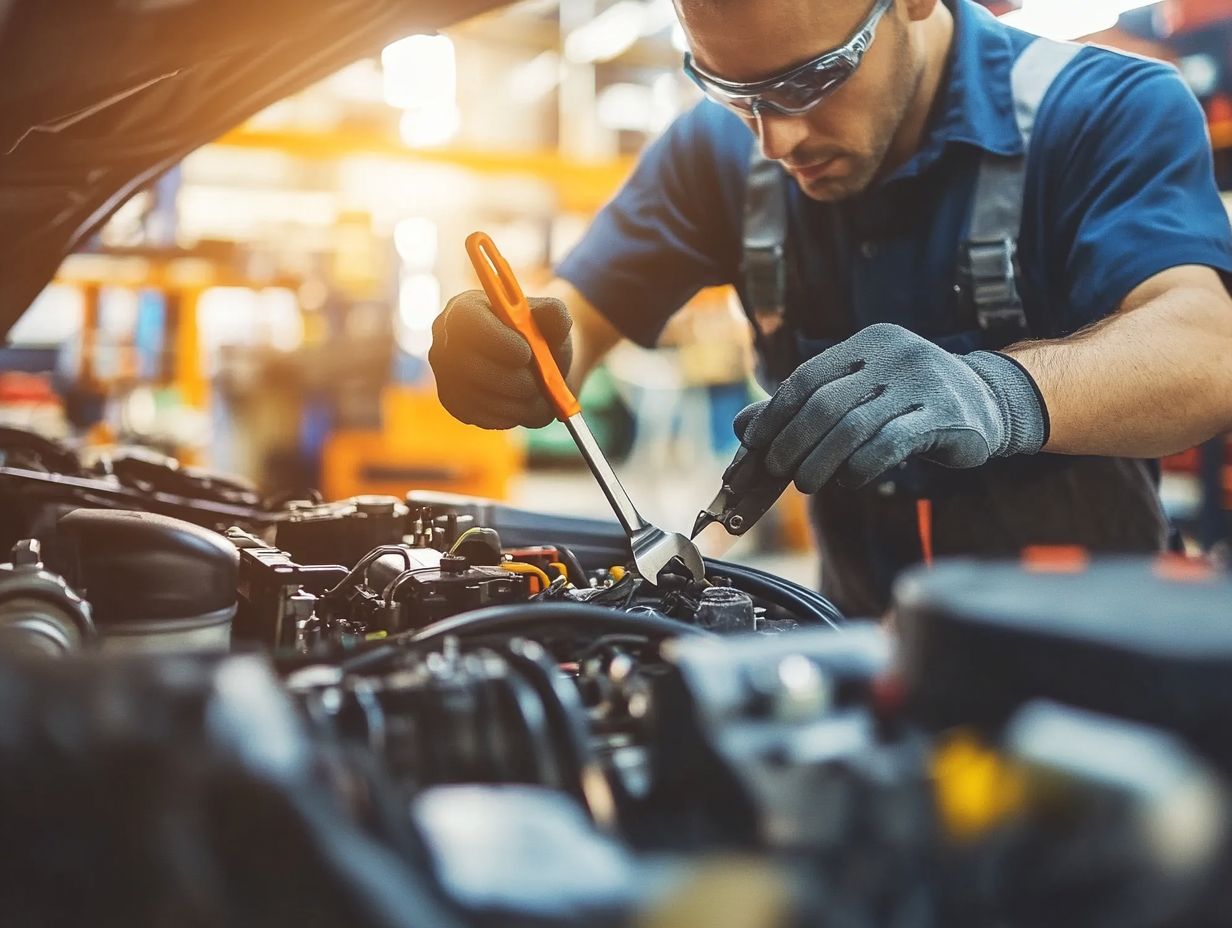
Here are some common questions about car maintenance:
- What are the 5 essential tips for common car maintenance?
The essential tips include regular oil changes, checking tire pressure, replacing air filters, inspecting brakes, and keeping the exterior clean. - Why is it important to regularly change the oil in my car?
Regular oil changes keep your engine running smoothly, as old oil can become dirty and thick, making it harder for your engine to function well. - How often should I check my tire pressure?
It is recommended to check your tire pressure at least once a month, as under or over-inflated tires can affect your car’s handling and fuel efficiency. - When should I replace my car’s air filters?
Air filters typically should be replaced every 12,000-15,000 miles, or more often if you frequently drive in dusty or polluted areas. - What should I look for when inspecting my car’s brakes?
Look for signs of wear like squealing or grinding noises, vibrations, or longer braking distances. If you notice these, it may be time to replace your brake pads. - How often should I wash my car’s exterior?
Wash your car s exterior at least once every two weeks to prevent dirt, debris, and road salt from damaging the paint and finish.
Upgrade to high-quality parts today for a safer, more efficient ride!


